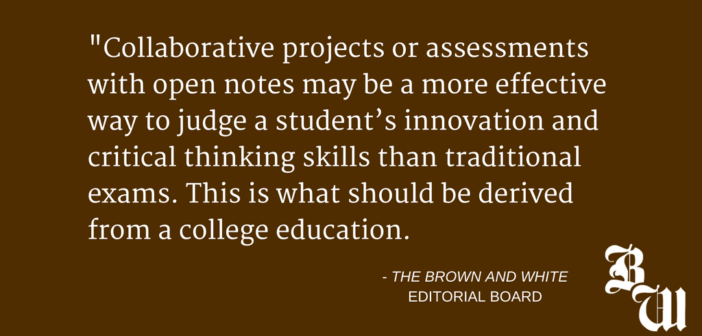Armed with pencils and coffee, students routinely pour into large classrooms for their 4 o’clock exams. After the hour, the students hand in their exam.
A few days or weeks later, the exam is returned with a grade that may not reflect the number of questions a student answered incorrectly. Instead, the grade on the exam reflects the student’s score after a curve was applied.
Curves are used to alter grades most often when the majority of the students in the class do not perform as well as expected. Changing students’ grades in this way does not reflect their grasp of the subject matter, yet it routinely occurs after every round of 4 o’clocks.
Exams should be changed in a way so students are tested so their grade reflects what they know.
Students should earn the grade they receive.
On a true curve, a certain number of students are given an A in the class, a certain number are given a B and so on. With this, both grade inflation and grade deflation can occur. Instead of a true curve, some professors simply add the number of points to the highest grade in the class to make it a 100. They then give all other students in the class the same number of points to their exam grades.
Both of these systems give students a grade that does not necessarily reflect their mastery of the subject. Grading on a curve, grade deflation and grade inflation merely reflect students’ performances as they relate to the grades of other students in the class.
When exams are given where the class average is a failing grade, a curve seems necessary so at least some students pass the class.
What is not necessary is the nearly impossible exam. While the point of an exam is to test students’ knowledge about a subject, that knowledge should be tested in a way that assess students’ ability to think critically, not their ability to weather an exam where the class average is below failing.
It is not that exams should necessarily be made easier so more students earn A’s, nor should exams be made harder to reduce the number of A’s given because it is the most common grade received by students in college, according to the Chronicle of Higher Education.
Exams should be constructed to accurately assess the knowledge of students. Both grade inflation and deflation should be eliminated.
This cannot happen instantaneously, however, because that would lead to large groups of students failing several classes. Curving also happens at almost all universities and colleges, meaning the grades Lehigh students receive are compared to the grades of students at other schools on internship and job applications. In the meantime, steps can be taken by Lehigh and all universities to phase out grade alteration.
Maybe this can be done with assessments that do not fit with the traditional mold of exams. Collaborative projects or assessments with open notes may be a more effective way to judge a student’s innovation and critical thinking skills. This is what should be derived from a college education.
Exams should be modified at all institutions so grades do not need to be altered in any way. A student’s grade at the end of the semester should be one that was earned, not one that was assigned relative to the grades of other students in the class.
Lehigh does not have a consistent policy on curves. Because of this, professors can choose to grade in the way they see fit. If most students fail the exam, there will most likely be a curve. This means students are often surprised by the grade they receive at the end of the semester.
Students spend four years taking exams that are factored into their GPAs. Those grades should reflect a student’s knowledge about the subject the test covers. Students should have the chance to earn the grade they deserve.






Comment policy
Comments posted to The Brown and White website are reviewed by a moderator before being approved. Incendiary speech or harassing language, including comments targeted at individuals, may be deemed unacceptable and not published. Spam and other soliciting will also be declined.
The Brown and White also reserves the right to not publish entirely anonymous comments.